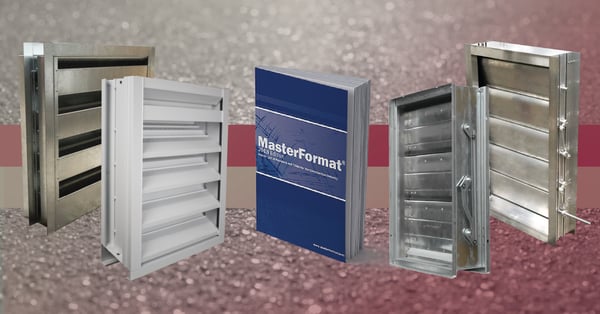Specifications are important documents that dictate how a building project moves forward. Learn what specifications are and why they are so important in this Newsstand article.
Keeping Your Project Track with Specifications
In construction, specifications are a comprehensive set of documents that specify every detail of the project. These documents contain everything there is to know about the future building: the building’s parts, the procedures used to install them, the materials used to make those parts, and how those parts are expected to perform.
.jpg?width=600&height=319&name=Spiral%20ducts%20in%20a%20factory%20(Resize).jpg)
Each part of the building will have a set of unique requirements to meet. For instance, a louver will need to allow a certain airflow to work within an intake point, while a fire damper will need to resist intense heat for a given amount of time. It's important that everyone understands the various requirements of each part when starting the project.
Specifications and Your Project
Specifications are written by architects and engineers with the building’s designs in mind. They will determine the various standards, codes, and performance requirements of each part of the building. Then, the specifications are handed to general contractors who will bring the various component parts together.
Depending on the spec type, contractors can make determinations on what products will meet these requirements. Once everything is in place, construction firms will begin building the project to the specifications. The specifications will cover each step of the process, providing each team with a blueprint for completing the project.
For larger projects, firms may call for a dedicated specifications writer to create the necessary documents. Certain companies may also use a specification program, like ARCAT’s SpecWizard, to generate the various sections of the document.
 Every building project needs a plan. Specifications define the terms and the requirements, setting the scope of the project. Specs keep everybody on the same page.
Every building project needs a plan. Specifications define the terms and the requirements, setting the scope of the project. Specs keep everybody on the same page.
Specification Types
There are three types of specifications in the construction industry: performance specifications, prescriptive specifications, and proprietary specifications. Each type takes a different approach to meeting the project’s requirements.
- Performance specifications focus on the requirements of the building. They specify a detailed list of what the building must do when it is complete. General contractors may choose the building materials and relevant products to meet these requirements. This is considered the most general type of spec. The focus of the document is on meeting requirements and not on the specific materials and products used.
- Prescriptive specifications provide details on which materials and products should be used and the installation process of those items. This spec will focus on the materials and products used. Most design choices have already been made by architects and engineers developing the spec. Prescriptive specs will have three sections:
- The general provisions section will detail the requirements set by codes and industry standards,
- The required products section will detail the type of products needed to meet those requirements and the necessary performance of each product, and
- The execution procedures will provide installation instructions and how to test effectiveness.
- Proprietary specifications are like prescriptive specifications, but with one key difference. Proprietary specs will specify only one type of product to be used for each installation. This spec type is typically used in situations where only the specified product type is known to meet the necessary requirements. This document will focus on products known to work. There is little room for substitution in this spec type.
Specifications can also be open or closed. An open specification will not name specific suppliers for products and materials. In an open spec, the spec writer may suggest multiple models of control damper for a single installation.
This allows suppliers to compete for that installation, assuming their products and materials meet the installation requirements. In general, performance specifications are considered the most open type of spec.
A closed specification will name the exact product and manufacturer to use for each installation. For example, a closed spec will call for a Model EA4DHP louver from Arrow United Industries instead of specifying a “wind driven rain louver” with a given performance rating. In this case, only the EA4DHP louver can be used for that installation. Proprietary specifications will be closed specs.
For prescriptive and proprietary specs, the document will describe the entire building process from start to finish. They will also define the requirements of the project and which institutions enforce those requirements. The primary difference between these spec types is the way they call for materials and products.
 Buildings will have requirements and standards. Every specification will list these requirements and the tools necessary to meet them.
Buildings will have requirements and standards. Every specification will list these requirements and the tools necessary to meet them.
The Master Format - Divisions, Subdivision, and Sections
Industry professionals use a standardized format to write their specs. In the USA, this standard format was created by the Construction Specifications Institute, known as the CSI MasterFormat. In the MasterFormat, each product type receives a three-part number to describe the product’s division, subdivision, and section in the CSI catalog.
In the 2018 edition of the CSI MasterFormat, stationary blade louvers are found under division 08 “Louvers & Vents”, subdivision 91 “Louvers”, section 19 “Fixed Louvers”.
All aspects of the construction process have a division in the CSI MasterFormat. For instance, division 01 addresses “General Requirements” like scheduling work for the project (01 32 13) and the proper procedures to follow during an emergency (01 35 29).
Note: CSI will update the MasterFormat on a regular basis. Numbers for divisions, subdivisions, and sections may change between iterations. For instance, the number for louvers mentioned in this article may have been updated since 2018. Always make sure to use the most up-to-date version of the MasterFormat when writing specifications.

The specifications will be organized into these same divisions. All stationary blade louvers will be listed in section 08 91 19 of the spec, when using the 2018 edition of the MasterFormat.
Adjustable blade louvers will be listed under 08 91 16 for “Operable Wall Louvers”. This organization ensures that any industry professional can open a specification document and quickly find what they are looking for.
The specifics of each product will be listed in each section, including its performance requirements, industry standards, and any necessary details about the product. In prescriptive and proprietary specs, these details will include the following:
- The product’s size and shape
- The size and shape of its individual components
- The materials used to make each part of the product
- How the product was assembled by the manufacturer
- Any options or accessories installed on the product
- If painted, the finish used and the color of the product
- All codes and standards the product will conform to
- All relevant performance data for the product
For a closed specification, sections will also list the manufacturer, and the model numbers of each product used in the project. Open specifications will list acceptable substitutes and alternative manufacturers for each product specified.
Specifications can be daunting. Whether it's an engineering spec, or architectural specifications, the specs provide the outline for the project. Every building project will coordinate multiple teams to complete the finished product. Everyone involved needs to be on the same page. Specifications make sure that everything is clearly defined, so that the completed building closely follows the initial design.
For more on project planning, check out these Newsstand articles about choosing louvers and dampers:
- The Big Three Metals for Louvers and Dampers
- Specifications for Louvers
- Five Things to Know When Selecting Dampers
Reviewing Specs with MCDLG
Are you working on a specification document of your own? MCDLG can help. We can review your specifications free of charge. Our sales team will make sure your document is free of errors, inconsistencies, or out-of-date information. And it’s okay if you specify other manufacturers. We won’t judge.
At MCDLG, we want you to have all the details exactly right. Visit our Contact Page, select “sales” in the department dropdown and then tell us what you need in “How can we help you?”. Tell us about your specification documents and what you want us to do. We will gladly help!
.webp?width=91&height=70&name=MCDLG%20Logo%20(Resize).webp)
.webp)





